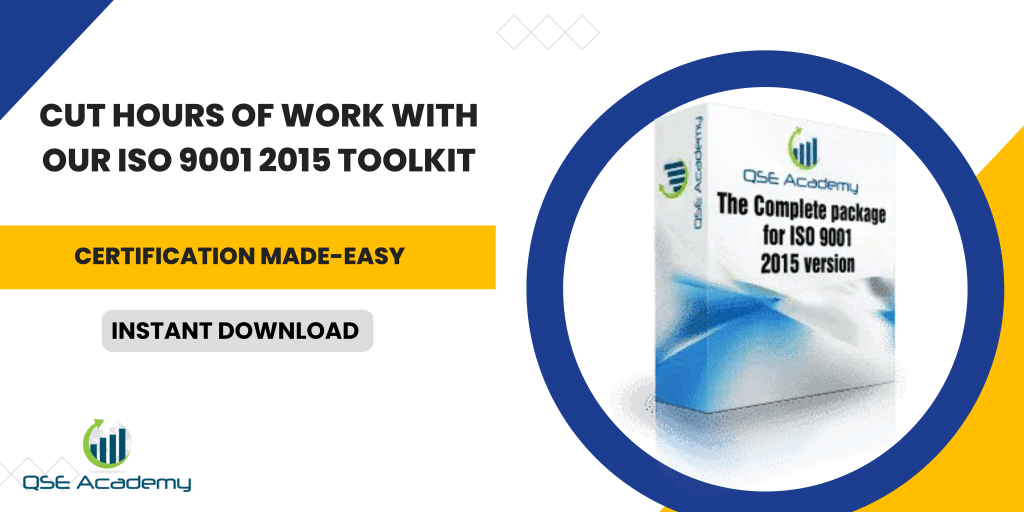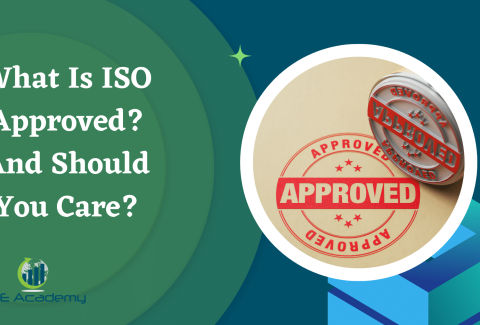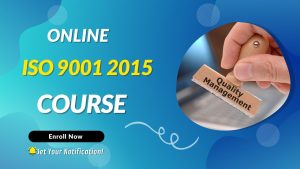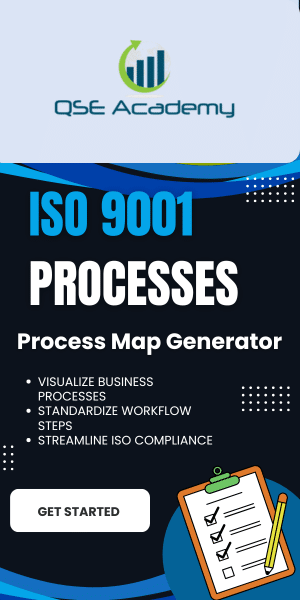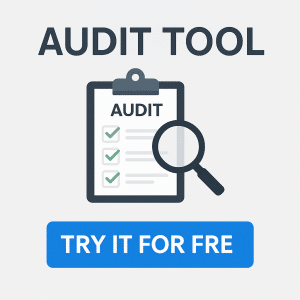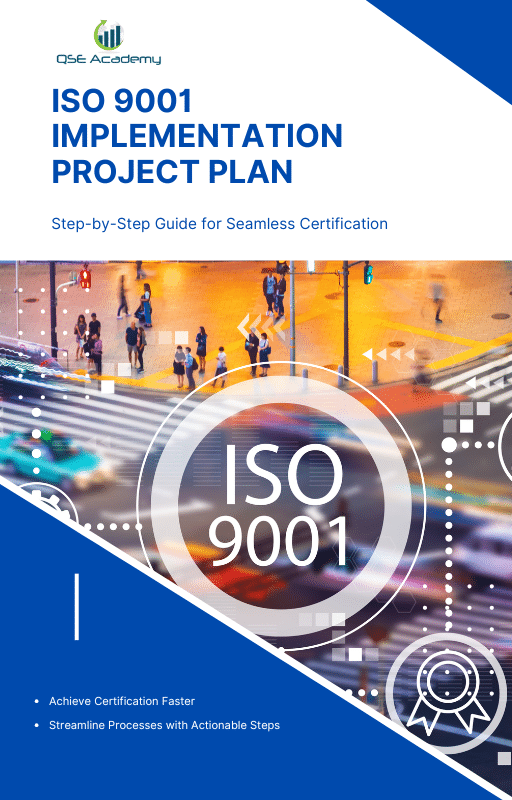How to prepare for an ISO 9001 audit ?
Last Updated on October 13, 2025 by Hafsa J.
How to prepare for an ISO 9001 audit ?
Let’s get real—most companies wait way too long before thinking seriously about their ISO 9001 audit. I’ve worked with startups, manufacturers, service providers—you name it—and the story’s always the same: panic sets in about a month before the audit date, and the team scrambles to fix documents, train staff, and cross fingers.
That last-minute rush? It never works well.
I’m Hafsa, ISO facilitator and audit consultant with over 10 years of hands-on experience preparing businesses for successful ISO 9001 certifications. I’ve supported dozens of clients—many with zero internal QHSE resources—pass their audits without a single major nonconformity.
If you’re reading this, you probably have an audit coming up. Maybe it’s your initial certification, maybe a surveillance audit, or maybe you’re just trying to clean things up before the external auditor walks in. Whatever your case, you’re in the right place.
In this guide, I’m going to walk you through everything that actually matters for ISO 9001 audit prep:
-
What auditors really look for (not just what the standard says)
-
How to structure your prep timeline so you’re never in fire-fighting mode
-
The most critical internal audit moves—and how to do them right
-
Common mistakes I’ve seen tank otherwise compliant companies
-
And how to get your team to actually be ready—not just pretend to be
You’ll also find links to more detailed guides on internal audits, surveillance audits, audit checklists, and becoming an ISO auditor yourself if that’s your long-term goal.
Bottom line? You’ll leave this article knowing exactly how to prepare—calmly, confidently, and with no surprises.
Know Which Audit You’re Actually Preparing For
Here’s what I’ve noticed—most people use the word “audit” like it’s one-size-fits-all. It’s not. If you don’t know what type of audit you’re preparing for, you’re already setting yourself up to miss key steps.
So, let’s break it down.
1. Certification Audit (Initial)
This is the big one. Your company is being audited to get certified for the first time. It usually happens in two stages:
-
Stage 1: Documentation review — the auditor checks if you’ve designed your QMS correctly.
-
Stage 2: Implementation audit — they verify whether you’ve actually applied the system in your day-to-day operations.
Tip: Stage 1 is where I see most clients get tripped up because they haven’t aligned procedures with their actual operations. Don’t just download templates—customize them.
2. Surveillance Audit
These happen once a year, usually in year 2 and 3 of your certification cycle. The purpose? Make sure you’re maintaining compliance and continuously improving.
Auditors won’t review everything—just selected processes. But don’t assume that means it’s “easier.” You still need to show you’re tracking KPIs, handling nonconformities, and reviewing performance regularly.
Related Guide: ISO 9001:2015 Surveillance Audit →
3. Recertification Audit
Every 3 years, your certificate expires unless you pass a recertification audit. This one is similar in depth to the original certification audit.
If you’ve been “barely compliant” for 3 years, this is where cracks show up. I’ve seen companies lose their certificate here due to poor document control and unclear responsibilities.
4. Internal Audit (Often Forgotten)
Internal audits aren’t optional—they’re mandatory and often your best defense before any external audit. You should be doing them at least once per year, or more often if your processes change.
Related Guides:
Quick Recap:
| Audit Type | Who Conducts It | When? | Key Focus |
|---|---|---|---|
| Certification | External cert body | At the start | Full system design + application |
| Surveillance | External cert body | Year 2 & 3 | Sample processes & evidence |
| Recertification | External cert body | Every 3 years | Full review again |
| Internal | Your team or consultant | At least once a year | Gaps before external audit |
Knowing which audit you’re facing is the foundation. Now that we’ve got that clear, let’s map out your prep timeline so you don’t end up doing everything in a panic.
Build a Bulletproof ISO 9001 Audit Prep Timeline
If I could give clients one piece of advice? Stop treating ISO audit prep like a last-minute cram session.
When you start early and plan smart, everything—from document control to team interviews—flows smoother. So let me walk you through the exact timeline I use when prepping clients for ISO 9001 audits.
3 Months Before the Audit: Foundation Check
At this point, you should already have:
-
A functioning Quality Management System (QMS)
-
Processes aligned with ISO 9001 clauses
-
Key documents updated and accessible
Here’s what to focus on now:
-
Schedule your internal audit if you haven’t already.
-
Update risk assessments and objectives to reflect current data.
-
Start collecting objective evidence (meeting minutes, monitoring records, NC reports).
Pro Insight: One client realized two weeks before their audit that their QMS software hadn’t saved version histories. We had to redo months of records. Don’t let that be you—start verifying early.
1 Month Before: Internal Audit & Management Review
Now’s the time to:
-
Conduct a full internal audit
-
Review findings and launch corrective actions
-
Hold your Management Review Meeting and document outcomes
Related Articles:
Tip: Your internal audit isn’t just a formality. Auditors often compare your internal findings to their own. If yours shows nothing, and they find major gaps—you’ll lose credibility fast.
1 Week Before: Final Run-Through
Here’s where I run a mini “mock audit” with my clients. We:
-
Walk through a simulated site tour
-
Do role-play audit interviews with department heads
-
Check that all documents and evidence are printed/digitally tagged
Ask yourself:
-
If the auditor asks, “Show me evidence of X,” can we retrieve it in 60 seconds?
-
Does each process owner know how their work ties to the QMS?
Pro Tip: Print a quick-reference folder with your ISO scope, org chart, Quality Policy, list of documented information, and a map of your process interactions. It impresses auditors—and keeps you grounded under pressure.
Audit Day: Calm, Confident, Clear
If you’ve followed the timeline above, audit day shouldn’t feel like a threat. It should feel like a conversation—one where you’re fully in control of your system, your team, and your evidence.
Master the Internal Audit Process (It’s Your Safety Net)
Here’s the truth most consultants won’t tell you—if your internal audit is weak, your external audit is already at risk.
I’ve had clients who thought they were audit-ready just because their documents were up to date. But when I dug into their internal audit reports, it was all surface-level: vague findings, no corrective actions, and no real evidence of process performance.
Let’s fix that.
What Is the Goal of an Internal Audit?
Not to “look good.” Not to tick a box.
The real goal?
To find weaknesses before the external auditor does.
A strong internal audit helps you:
-
Catch nonconformities early
-
Practice responding to findings
-
Build confidence in your process owners
-
Strengthen your continuous improvement culture
How to Conduct an Internal Audit That Actually Works
Here’s what I walk clients through:
1. Build an Internal Audit Plan
-
Cover all processes over your audit cycle (usually 12 months)
-
Prioritize high-risk or non-performing areas
-
Assign trained auditors (they can’t audit their own work)
2. Use a Proper Checklist
-
Your checklist should be based on ISO 9001:2015 clause requirements, not just general questions
-
Include process-specific items like KPI monitoring, risk management, and customer feedback
Related Resources:
3. Record Findings With Clarity
-
Each finding must include:
-
Clause reference
-
Objective evidence
-
Risk assessment (e.g. low/medium/high)
-
-
Include both conformities and nonconformities
4. Follow Up With Corrective Actions
-
Don’t stop at the audit report
-
Launch root cause analysis for NCs
-
Assign responsible persons + deadlines
Common trap: Internal audit shows “no issues,” but complaints and delays are piling up in operations. That’s a red flag for the certifying body—it shows your QMS isn’t connected to reality.
Real-World Example:
One of my clients, a logistics company, kept passing audits by the skin of their teeth—until a surveillance audit flagged a process with zero internal audit coverage in 18 months. Why? Their internal auditor left and no one reassigned the task.
That simple gap cost them a major nonconformity—and a very stressful re-audit.
Final Thought:
A strong internal audit isn’t about perfection—it’s about honesty and ownership. When you treat it like a true risk management tool, the external audit becomes a formality.
Prep the Documents Auditors Always Ask For
Let’s be blunt—no matter how confident your team sounds in interviews, if your documentation is a mess, your audit will not go well.
Auditors don’t want just talk—they want traceable proof. And they want it fast.
So here’s exactly what to have ready.
Mandatory ISO 9001:2015 Documents & Records
Whether you’re heading into a certification, surveillance, or recertification audit, the following are non-negotiables:
Core Documents:
-
Quality Policy (Clause 5.2)
-
Quality Objectives and planning (Clause 6.2)
-
Scope of the QMS (Clause 4.3)
-
Process interaction map
-
Documented procedures (as needed per Clause 4.4 and others)
-
Risk and opportunity actions (Clause 6.1)
Required Records:
-
Monitoring and measurement results (Clause 9.1)
-
Internal audit results (Clause 9.2)
-
Management Review outputs (Clause 9.3)
-
Nonconformities and corrective actions (Clause 10.2)
-
Training/competence records (Clause 7.2)
Want to deep-dive this? Check What is involved in the ISO 9001 audit?
Optional (but Expected) Documents That Impress Auditors
These aren’t formally required, but in my experience, they always get asked for:
-
Process KPIs and dashboards
-
Customer feedback summaries
-
Version-controlled procedures
-
Calibration or maintenance logs
-
Supplier evaluation forms
Pro Tip: I always recommend a master “Document Control Index.” It lists all QMS documents with version numbers, owners, and dates. It gives the auditor instant visibility into your control system—and it shows you’re organized.
Document Tips from the Field
-
Keep a digital + printed copy ready: Auditors often ask for hard copies to review or mark up.
-
Don’t over-decorate: Fancy formatting isn’t a substitute for clarity. If a document looks great but doesn’t reflect reality, it’ll hurt you.
-
Version control is everything: I once had a client show two different versions of the same procedure in two meetings—instant credibility loss.
Real Example: Why “Accessible” Isn’t Always “Ready”
One of my clients used a cloud QMS system. Everything was technically “there,” but when the auditor asked for a specific risk analysis, we spent 20 minutes digging through nested folders and file versions. That delay created unnecessary pressure and led to multiple follow-up questions.
After that? We implemented a “Top 20 Documents” folder that we update and rehearse before every audit.
Get Your People Ready for the Audit Interview
Let’s be real—auditors don’t just look at your system, they look at your people. And they can tell within 30 seconds if someone was coached the night before.
In my experience, the teams that perform best in audits aren’t the ones who memorize answers—they’re the ones who genuinely understand how their role connects to the QMS.
Let me show you how to make that happen.
What Auditors Typically Ask Employees
When auditors walk around, they’ll casually ask:
-
“What’s your process for handling a nonconforming product?”
-
“How do you know if you’re meeting your objectives?”
-
“Where can you find the latest version of your procedure?”
And most importantly:
“How does your work support quality?”
If your people shrug or say, “That’s the quality manager’s job,” you’re in trouble.
Simple Ways to Prepare Your Team (Without Overcoaching)
Here’s what I do with every client before an audit:
1. Department-by-Department Alignment
-
Meet with each department head
-
Review their key processes, KPIs, and associated documents
-
Make sure they understand how their work links to ISO 9001 clauses
2. Short Awareness Training Sessions
-
30–45 minutes is enough
-
Cover:
-
The audit scope and purpose
-
What to expect during auditor walkthroughs
-
Key phrases (e.g., “We follow procedure QMS-PR-04 for that”)
-
Bonus Resource: What does ISO 9001 compliant mean?
3. Quick Reference One-Pagers
Create one-pagers for each process:
-
Process purpose
-
Inputs/outputs
-
KPIs
-
Link to documented procedures
-
Recent improvements made
This isn’t just for auditors—it helps your team build real clarity about their roles.
Pro Tip: Avoid the “Script Trap”
Coaching employees to recite perfect answers backfires. Auditors spot it instantly. Instead:
-
Use role-plays to explore, not memorize
-
Teach staff how to ask for clarification:
“I’m not sure how to answer that—can I show you how we do it instead?”
That shows honesty and awareness—two things auditors respect.
Field Story: When an Operator Saved the Audit
I once worked with a packaging plant where the floor supervisor had barely finished high school. During the audit, the auditor asked him about the nonconforming product procedure.
He didn’t use fancy language.
He said:
“If it doesn’t match the spec, I move it to the red zone, tag it, and fill out form NC-02. My lead checks it before we throw it out or rework it.”
The auditor looked at me and said, “Perfect answer.”
What to Do After the Audit (Especially If You Get Findings)
Let’s be honest—the real work often starts after the auditor leaves.
I’ve seen companies breathe a huge sigh of relief when the closing meeting ends… and then completely stall on follow-up actions. That’s a fast track to losing your certificate or failing the next surveillance audit.
So let’s talk about how to handle audit outcomes like a business that actually takes quality seriously.
Step 1: Review the Audit Report Carefully
The auditor’s final report will include:
-
Positive observations
-
Opportunities for improvement (OFIs)
-
Minor and major nonconformities (NCs)
Here’s what each means:
-
OFI: You’re compliant, but could be doing better. Use this to improve—don’t ignore it.
-
Minor NC: A small gap in your system. Needs correction and proof within a deadline (usually 30 days).
-
Major NC: A system failure. Needs urgent action and sometimes a follow-up audit.
If you get a major NC, don’t argue or panic. Focus on root cause, not blame.
Step 2: Launch a Corrective Action Plan (CAP)
You’ll need to:
-
Identify the root cause — not just the symptom
-
Define a real fix — one that addresses the process, not just the instance
-
Assign owners and deadlines
-
Collect and submit evidence — revised procedures, new records, photos, etc.
Related: How do I become an ISO 9001 auditor?
(Seeing the audit from the other side helps you write better CAPs.)
Pro Tip: Don’t just fix what was found. Use it as a trigger to review the whole process. Auditors remember companies who truly improve—not just patch things.
Step 3: Prepare for Surveillance (If This Was a Cert Audit)
If you just passed your initial certification, congrats!
Now you have 12 months before your first surveillance audit. Don’t wait 11 months to get back into audit mode.
Here’s what to do:
-
Keep your internal audit plan active
-
Monitor KPIs regularly and record evidence
-
Continue training new staff on QMS awareness
-
Track actions from Management Reviews
Related Guide: ISO 9001:2015 Surveillance Audit
Real Client Insight
I had a client who got 2 minor NCs on their first audit. Instead of brushing them off, they overhauled the whole root cause analysis process. One year later? The auditor said, “That’s one of the best continuous improvement systems I’ve seen this year.”
That’s how you turn audit pain into strategic gain.
Common Mistakes (and How to Avoid Them Like a Pro)
I’ve prepared dozens of companies for ISO 9001 audits, and I’ve seen the same patterns again and again. These aren’t just mistakes—they’re signals to an auditor that your system is cosmetic, not operational.
Let’s break them down so you don’t fall into these traps.
Mistake #1: Relying on Templates Without Customization
Let’s be blunt—if your quality manual talks about “manufacturing operations,” but you run a consulting firm, auditors will see through it in seconds.
What to do instead: Start with templates if needed, but adapt them to your actual operations. Use real process names, people, and flows. Your QMS should feel like your business.
Mistake #2: Leaving Internal Audits to the Last Minute
This is one of the fastest ways to get caught. A rushed internal audit:
-
Lacks real evidence
-
Misses risks
-
Shows you aren’t taking ISO seriously
What to do instead: Schedule your internal audit at least 4–6 weeks before the external audit. Give yourself time to launch corrective actions and show closure.
Mistake #3: Overcoaching Staff
I mentioned this earlier, but it’s worth repeating. If your team sounds robotic or rehearsed, auditors dig deeper. You don’t want that.
What to do instead: Train your team to speak naturally about what they actually do and how they follow procedures. Confidence > memorization.
Mistake #4: Treating the Audit as an Event, Not a Process
Some companies go into “audit mode” once a year… and ignore quality the rest of the time. Auditors see right through that.
What to do instead: Use your QMS as a daily tool—track KPIs monthly, hold real management reviews, and update procedures when things change.
Top 3 Reader FAQs (Answered Fast)
Q1: How often is the ISO 9001 audit done?
A: After certification, you’ll face a surveillance audit annually and recertification every 3 years.
Q2: What happens if I fail the audit?
A: You’ll receive major nonconformities and need to correct them within a strict deadline—typically 30 to 90 days. In severe cases, certification may be suspended.
Q3: How do I know if I’m ready for audit?
A: You’re ready when:
-
Internal audits are done and closed
-
Management Review is documented
-
You can retrieve all required records in under a minute
-
Your team is aware and confident
You’re Closer to Ready Than You Think (If You Do the Right Things)
Here’s what I want you to take away from this:
ISO 9001 audits aren’t about perfection—they’re about clarity, consistency, and control.
You don’t need to guess what the auditor wants. You just need to:
-
Understand which audit you’re preparing for
-
Follow a clear prep timeline
-
Run a meaningful internal audit
-
Get your documentation airtight
-
Prepare your people to speak confidently
-
And respond to findings like a business that owns its quality
I’ve walked this path with startups, factories, food companies, consulting firms—you name it. The ones who succeed are the ones who treat ISO as a tool, not a hurdle.
Your Next Steps:
Want a done-for-you checklist?
Download my ISO 9001 Audit Preparation Kit – it includes a timeline planner, internal audit templates, and a staff awareness guide.
Need 1:1 guidance?
Book a 30-minute strategy session with me. I’ll assess your current system and help you build a rock-solid audit plan.
Continue your audit journey:
Explore these focused guides:
Final Word:
Audit day doesn’t have to feel like judgment day.
When you’re prepared, confident, and organized, it becomes what it’s meant to be: proof that your business knows what it’s doing.
You’ve got this. And if you need backup—I’m here.
Ready to move from ISO 9001 theory to implementation?
Get the exact tools you need to write your documentation, train your team, map your processes, and pass your audit—without wasted time or guesswork.
Whether it’s ISO 9001, ISO 22000, or the cosmetics-focused ISO 22716, I’ve spent my career I’m not here to call myself an expert—I prefer “enthusiast” because I truly love what I do. When I’m not writing about standards, you’ll probably find me playing Piano 🎹, connecting with people, or diving into my next big project💫. I’m an engineer specialized in the food and agricultural industry
make ISO standards less intimidating and more approachable for everyone.
turning complex jargon into clear, actionable steps that businesses can actually use.
There’s something incredibly rewarding about helping people navigate food safety and quality management systems
in a way that feels simple, practical, and even enjoyable.
I have a Master’s in QHSE management and over 12 years of experience as a Quality Manager
I’ve helped more than 15 companies implement ISO 9001, ISO 22000, ISO 22716, GMP, and other standards
My clients include food producers, cosmetics manufacturers, laboratories, and service companies
I believe quality systems should be simple, useful, and efficient.


